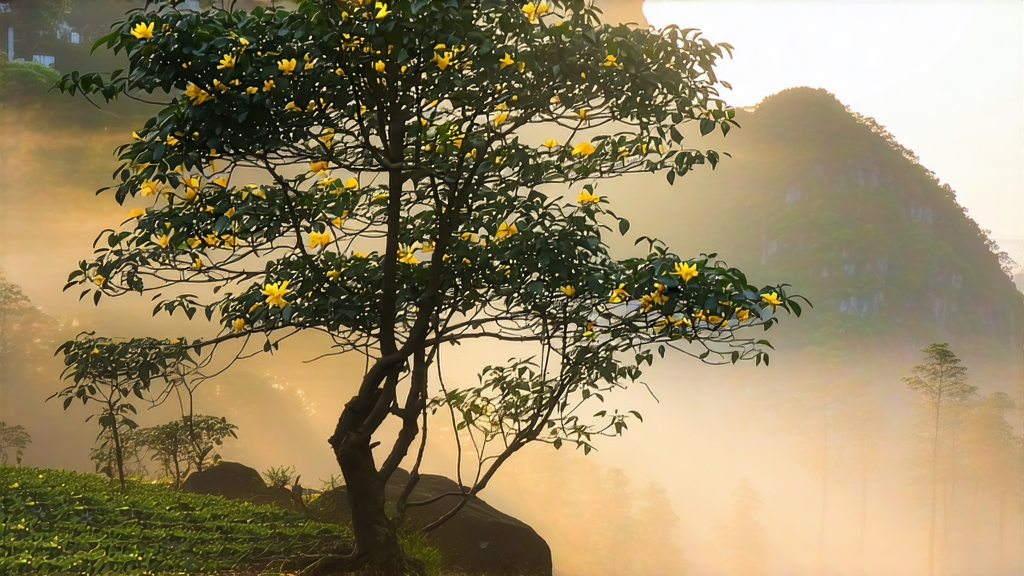
Tucked high on mist-crowned Mengding Mountain in Sichuan Province, Mengding Huangya—literally “Yellow Bud from Mengding”—is the oldest documented yellow tea on earth, yet the least known outside China. While green tea’s jade freshness and pu-erh’s earthy depth have travelled the globe, this luminous, slightly honeyed liquor has remained a guarded secret of emperors, monks and a handful of mountain families for twelve centuries. To meet it is to taste the slow, patient art of “sealed yellowing,” a process so subtle that even seasoned tea traders sometimes mistake it for a green tea that has aged a few months. In truth, Mengding Huangya is a category of its own, a living fossil of Chinese tea craft whose flavour hovers between the bright grassiness of spring and the mellow sweetness of autumn orchards.
History: from imperial altar to forgotten grove
The first written record appears in A.D. 724, when the Tang court dispatched tea officers to Mengding to supervise the spring picking for the imperial altar of heaven. The mountain’s 1,450-metre elevation, perennial cloud cover and sandy, slightly acidic soil produced buds so pale they looked ivory in the moonlight; palace scribes called them “immortal tips.” By Song times the tea had become a fiscal currency—one cake of Mengding Huangya could exempt a household from three months of salt tax. When the Ming emperor abolished compressed tribute teas in 1391, the intricate yellowing technique almost vanished. Only a few Buddhist monasteries on Mengding kept tiny plots, using the tea as medicine for meditation fatigue. For five centuries the cultivar survived as bonsai-like shrubs hidden behind temple walls, until a 1954 government survey rediscovered 37 ancient trees and re-established commercial production. Today less than 3,000 kg of authentic Mengding Huangya reach the market each year, making it rarer per gram than silver.
Cultivar and picking calendar
The original population are seed-propagated descendants of Camellia sinensis var. sinensis locally called “xiao-ye-zhong” (small-leaf stock). Their dormant winter phase lasts 180 days—40 days longer than plains tea—allowing amino acids to accumulate. Picking begins on the first day after Grain Rain (around 20 April) when morning mist lingers until 10 a.m. Only the single terminal bud plus the half-unfolded first leaf are taken, a standard known as “one flag, one spear.” A skilled picker gathers just 200 g in four hours; 60,000 such sets yield one kilogram of finished tea.
Craft: the invisible 72 hours that create yellow
The magic lies in men-huang—“sealed yellowing”—a slow oxidation phase slipped between killing-green and final drying. The freshly withered buds are pan-fired at 160 °C for four minutes to destroy leaf enzymes, but the leaves are immediately piled into linen sacks while still 60 °C inside. Over the next three days the sacks are opened every eight hours to release trapped carbon dioxide, then re-sealed. During this sauna-like limbo chlorophyll gently breaks down, polyphenols oxidise just enough to round the edges, and a faint golden pigment called chrysoxanthin forms. Because the leaf looks greenish-yellow rather than the deep yellow of Huang-daqing or Junshan Yinzhen, outsiders often underestimate the step, yet without it the tea would lack the hallmark note of steamed chestnut and dried longan.
Final shaping is done over a bamboo charcoal brazier whose temperature is judged by the colour of ash—pearly grey means 70 °C, perfect for hand-rubbing the buds into slightly curved hooks. When complete the moisture reads 5 %, and a single bud can be laid on a calligraphy page without leaving an oil trace, the old merchants’ test of dryness.
Grades and market names
Three grades reach consumers. “Imperial Tip” (cha-wang) consists entirely of unopened buds picked before 6 a.m.; it steeps into a champagne-coloured liquor with a lingering orchid finish. “Golden Spear” (jin-qian) contains 20 % first leaf and delivers a thicker, broth-like body favoured by Sichuan chefs for palate cleansing during hot-pot banquets. “Mist Curl” (yun-zuan) is made from buds harvested in the secondary flush ten days later; still fragrant, it is the grade most often seen abroad. Counter